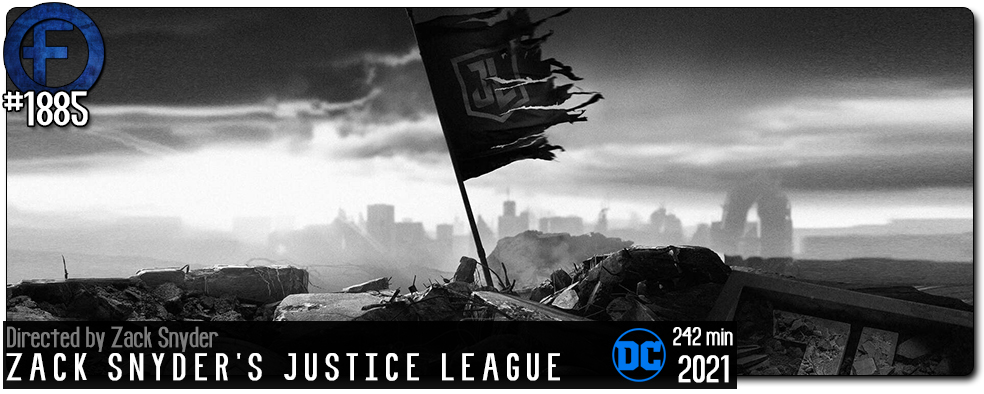Movie Review – Zack Snyder’s Justice League
Principal Cast : Ben Affleck, Henry Cavill, Amy Adams, Gal Gadot, Ray Fisher, Jason Momoa, Ezra Miller, Willem Dafoe, Jesse Eisenberg, Jeremy Irons, Diane Lane, Connie Nielsen, JK Simmons, Ciaran Hinds, Joe Morton, Joe Manganiello, Amber Heard, Harry Lennix, Kiersey Clemons, Zheng Kai, Karen Bryson, Peter Guinness, Ray Porter, Marc McClure, Jared Leto.
Synopsis: Determined to ensure Superman’s ultimate sacrifice was not in vain, Bruce Wayne aligns forces with Diana Prince with plans to recruit a team of metahumans to protect the world from an approaching threat of catastrophic proportions.
********
Warning: Plot Spoilers within….
With a groundswell of fan support and a studio willing to buckle to constant social media campaigns to have it restored, the official Zack Snyder version of 2017’s vicariously enjoyable but legitimately execrable Justice League, then the culmination of the director’s universe-building tryptic that started with Man of Steel, and continued with Batman V Superman (and encompassed indirectly the events of Wonder Woman), has finally made its way out into the public eye. Long mooted a pipe-dream by fans, the #SnyderCut of Justice League eventuated following the sudden departure of Snyder from the film’s production back in 2017 following the sudden and tragic passing of his daughter, Autumn. Warner Bros brought in journeyman director Joss Whedon, gave him a slew of notes and about three minutes to change the movie entirely (including extensive reshoots), and released their team-up movie to critical evisceration and lacklustre box-office. Although Snyder was off the project, word of his lengthier darker cut of the film began to surface, enabled not only by the director himself in due course but also the stars of the film, most of whom supported the fans desire to see the filmmaker return to complete his bastardised movie the way he originally wanted to. Countless fan campaigns, petitions and fundraising efforts later, the Snyder Cut (as it became known) was given the green light by Warner Bros, with the studio thrusting an additional $70m at the director to enable him to complete various visual effects, shoot some new stuff, and restore his original vision for the movie. Given the original theatrically released film ended up costing the studio around $300m to produce (including reshoots and delays), and the Snyder Cut contains none of the material Whedon filmed following Snyder’s departure, this release somehow has to recoup such extravagant expenditure to make any kind of profit; that it has dropped exclusively on streaming platforms across the globe means it will never achieve this quickly, if at all, making dissection of what is potentially Snyder’s greatest folly all the more intriguing.
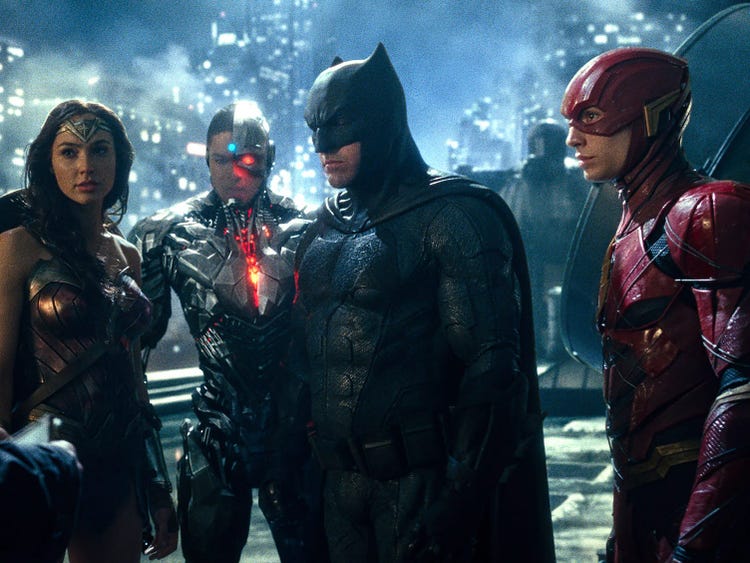
Superman (Henry Cavill) is dead at the hands of Doomsday. Batman (Ben Affleck) and Wonder Woman (Gal Gadot) learn of a new threat to Earth; the forces of Apokolips, led by the cruel Steppenwolf (Ciaran Hinds) at the command of Darkseid (Ray Porter) are intent on recapturing three mysterious “mother boxes”, powerful devices with which they can lay waste to and subsume entire worlds. With global annihilation at hand, Batman recruits several other “metahumans” – the water dwelling Arthur Curry, aka Aquaman (Jason Momoa), the cyborg Victor Stone (Ray Fisher), and speedster The Flash (Ezra Miller) – to face the threat. But they cannot do it alone: they concoct a daring plan to resurrect Superman, in the hope that he can lead their league of justice to victory against the cosmic forces of doom.
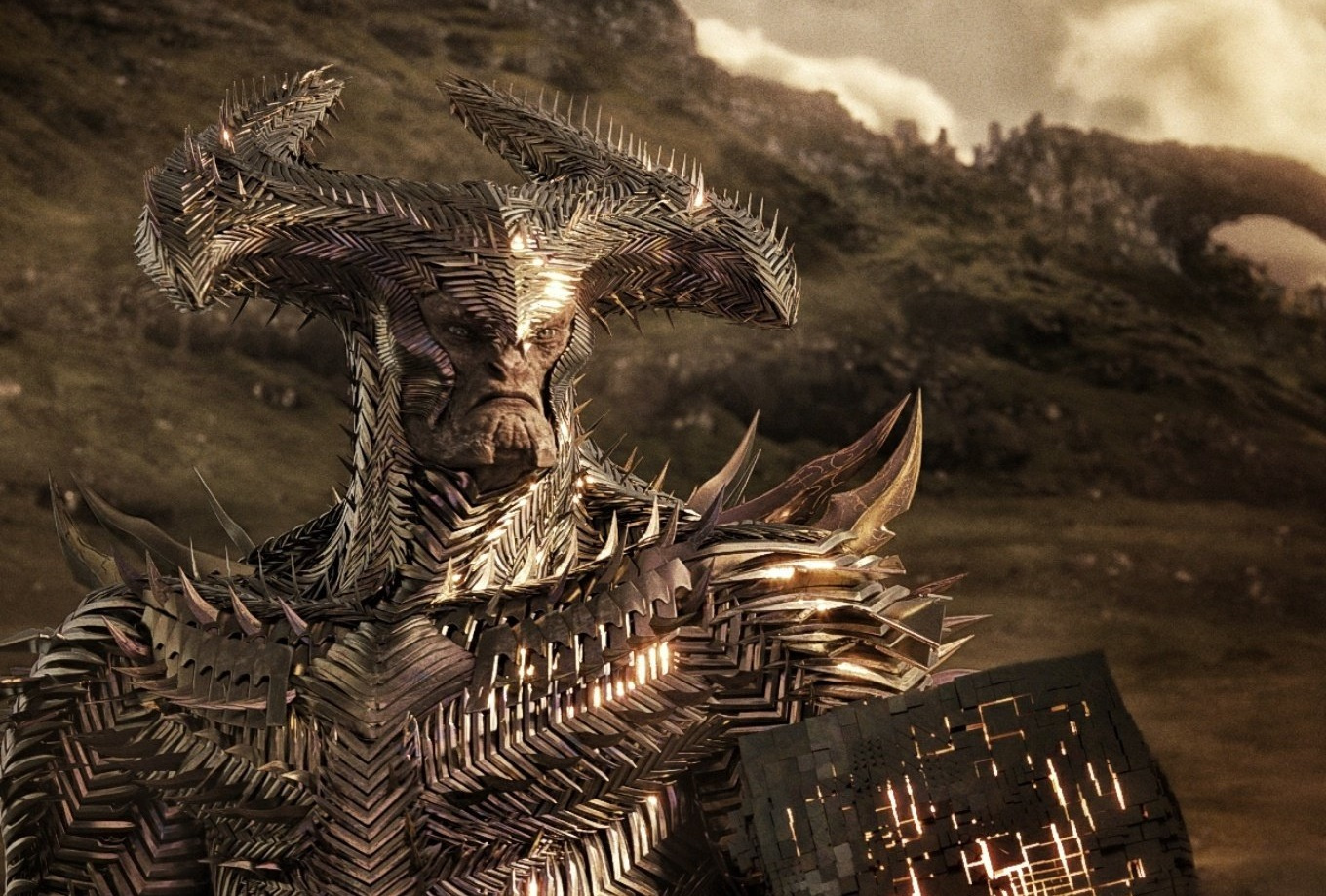
Clocking in at a bladder-bursting four hours, Zack Snyder’s Justice League wants not for time in which to satisfy its story, character and action demands. Thankfully, the film’s streaming release affords people the freedom to press pause, toddle to the bathroom, refill their soda cup, and continue in their own time this bombastic, emotionally satisfying and decidedly superior version of the first on-screen live-action League of Justice. Snyder’s mandate with this cut was to deliver the definitive version of the film – or films, plural, given the original original plan was to split Justice League into two films, a la Marvel’s Infinity War and Endgame duo – described by Warner Bros boss Walter Hamada as a “cul de sac” for the self-styled “Snyderverse” as the studio looked to reboot their comic book movie output with a new take on Batman, and other un-Snyder-ised projects. That the Snyder Cut has met with such acclaim from both fans and critics might seem to indicate that there is life left in the Snyderverse yet, although only time will tell if Warner Bros or Snyder himself will return to what has become quite a poisoned well. Snyder reintegrated so much material excised from the Whedon release that approximately 75% of this film contains new and barely ever seen footage, most of which serves to flesh out established characters, lengthen action beats and provide entire new arcs for the story to transpire. The overall plot remains the same as the Whedon version, although the Snyder Cut takes a lot longer, and is far more satisfying, to get there.
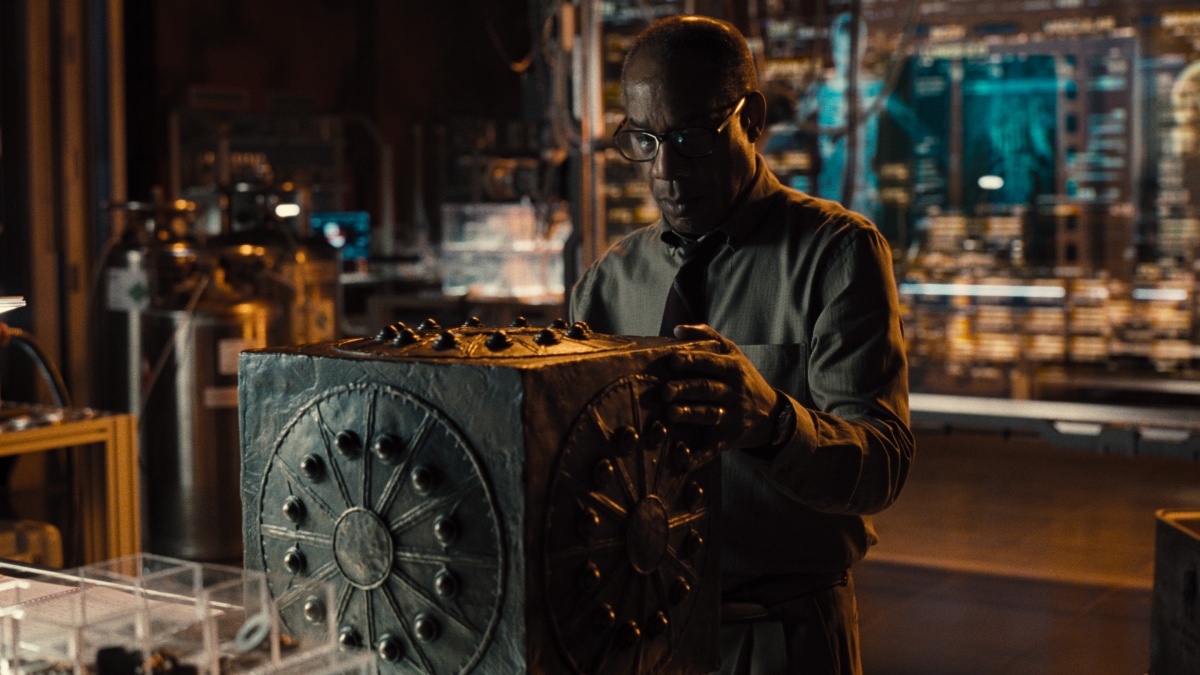
Of the seven featured heroes in the movie, two of them are given substantially more development, which doesn’t just provide the viewer more emotional beats, it also widens the stakes and the sense of peril when shit starts to go down. The first of these if Ezra Miller’s Flash, Barry Allen, whose father Henry (Billy Cruddup) rots in prison over the apparent murder of his mother. Snyder gives Miller’s character a really playful sense of youth – the kid is what, in his teens or early twenties in the film, so still enthusiastic about his powers and what he can do with them – and the film explores this facet of Allen’s character brilliantly. His dialogue is witty without stooping to inane comedy, and his chemistry with Affleck’s Bruce Wayne is the film’s standout dynamic. With Bruce losing his young ward, Jason Todd, sometime before the events of Batman V Superman, and Barry effectively losing both parents, their respective isolation contrasts against their paternal friendship and makes for amusing and endearing viewing.
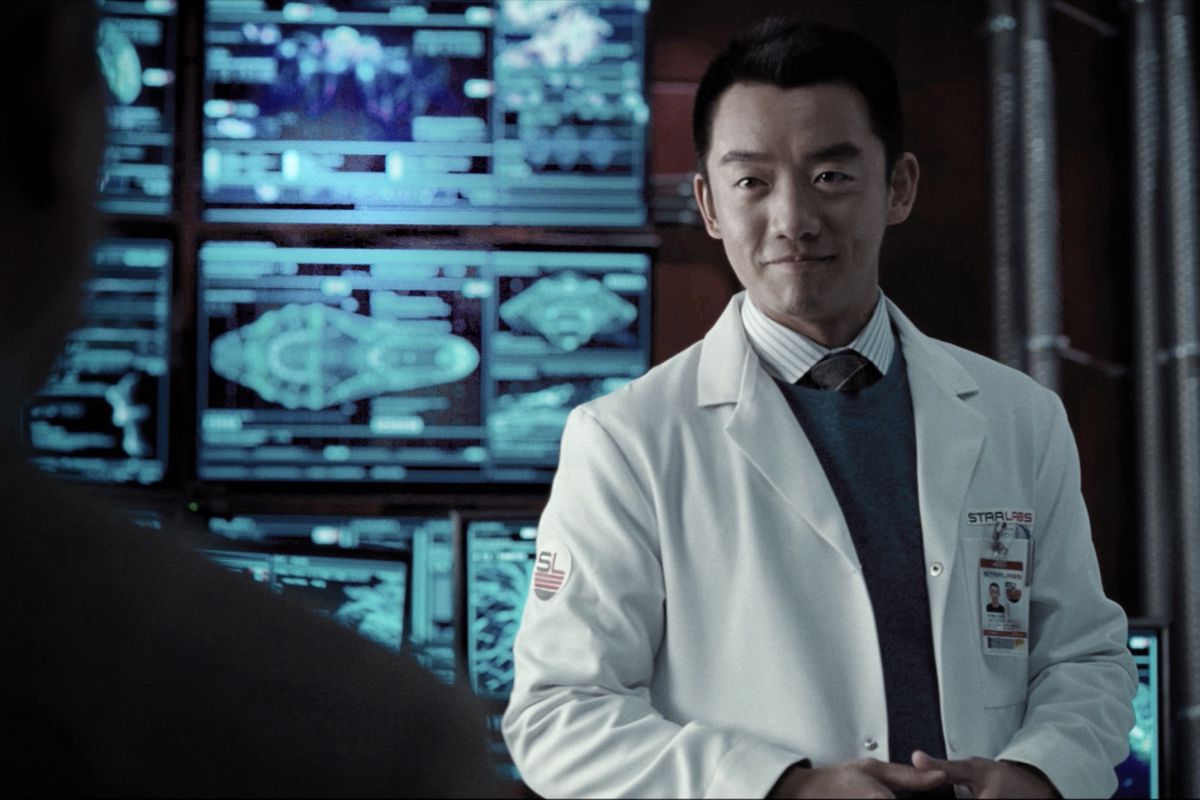
Complementing this shift in focus is the enormous amount of time given to Ray Fisher’s Cyborg role, a role which I described as the “heart and soul” of the Whedon cut but it was quite obvious a lot of his backstory and subtextual narrative had been removed. The Snyder Cut is the Cyborg’s movie, as fantastic, emotive and grounded an origin story as you’ll see anywhere, and combined with Fisher’s heavyweight performance with the always-excellent Joe Morton, whose role as Cyborg’s father is equally expanded, offers a far heftier human story that quite possibly will move you to tears. Cyborg was created out of a last-ditch effort to keep the recently deceased Victor Stone alive; Victor’s scientist father used the power of one of the Mother Boxes to transform his son into a half-human, half-robot superhuman, quite literally a metal Frankenstein’s Monster, in order to save his life, causing the subject to question whether or not he is still human and what his new purpose is. The role is a revelation for Ray Fisher’s acting chops, and even when he’s playing up to the superheroic mantra of all good comic book films, the actor embraces and fully inhabits the role.
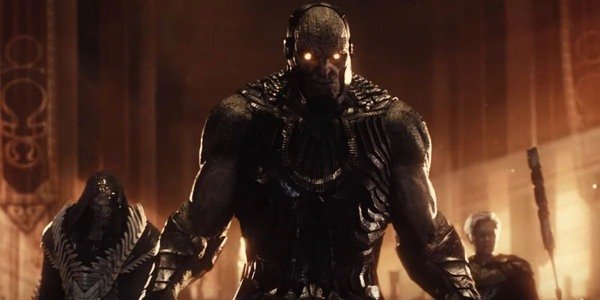
With respect to the other members of the league, neither Wonder Woman or Aquaman come in for better or worse treatment in the Snyder Cut, although there are a lot less – if any – hypersexualised moments of Gal Gadot’s femininity flaunted in our faces, such as those depicted in Whedon’s reshoots. Gadot’s Diana Prince is a major force to be reckoned with, as well as a sense of playfulness when heading into battle with a reprise of the Doomsday-fight smile she gives off when it comes time to showdown with Steppenwolf. Sadly, nay bizarrely, Gadot’s performance here is quite wooden, the actress perhaps still feeling her way with the character and her ability to deliver dialogue and act, something she couldn’t muster at all in her Fast & Furious movies. Her repartee with Affleck is good, if only because Affleck’s a solid enough actor to carry their scenes despite Gadot’s blandness, and when she put on that iconic suit of armour she kicks ass like nobody else, but at the time she filmed this, she was hardly an Oscar-level actress. Jason Momoa’s Aquaman is still quite the ambivalent character here, and Snyder tones down the surfer-dude mentality a lot making the character more serious than he was in Whedon’s edition. Momoa still seems to be having fun, but the Snyder Cut doesn’t offer much more to his role than we saw in the theatrical version, leaving the bulk of his backstory and development to occur in his stand-alone film.
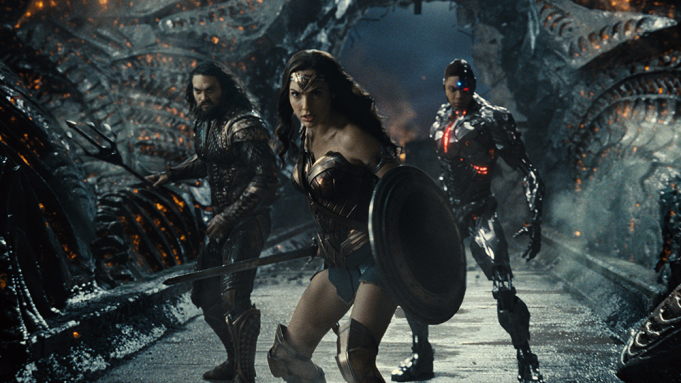
When he eventually returns to life, Henry Cavill’s Superman once again showcases the dour, melancholy Superman at-odds with his place in the world, which I found disappointing. The decision to garb the resurrected Kryptonian in his iconic Black Suit (in the comics, Superman’s black suit was utilised as a recovery outfit of sorts following his revival from death during the famous 1993 storyline) will sit well with most, but keeping him in it beyond his immediate resurrection felt a touch… off. In keeping with Snyder’s refusal to allow Cavill’s Superman to be fun, draping him in a mourning outfit when he shoulders arms to help his comrades against Steppenwolf only accentuates his dreary, monotone sadness at existing. It’s a nice nod to the comics, but I think Snyder leant too heavily into the cool fan-service with this than the moment deserved. Surprisingly, Superman appears late in the film in his famous red and blue outfit during a reprise of the alternative “Knightmare” universe timeline, glimpsed in Batman V Superman, without explanation as to why this might be the case. Cavill physically suits the role and there is not a single frame of “digital moustache removal” footage to be seen, thank the New Gods.
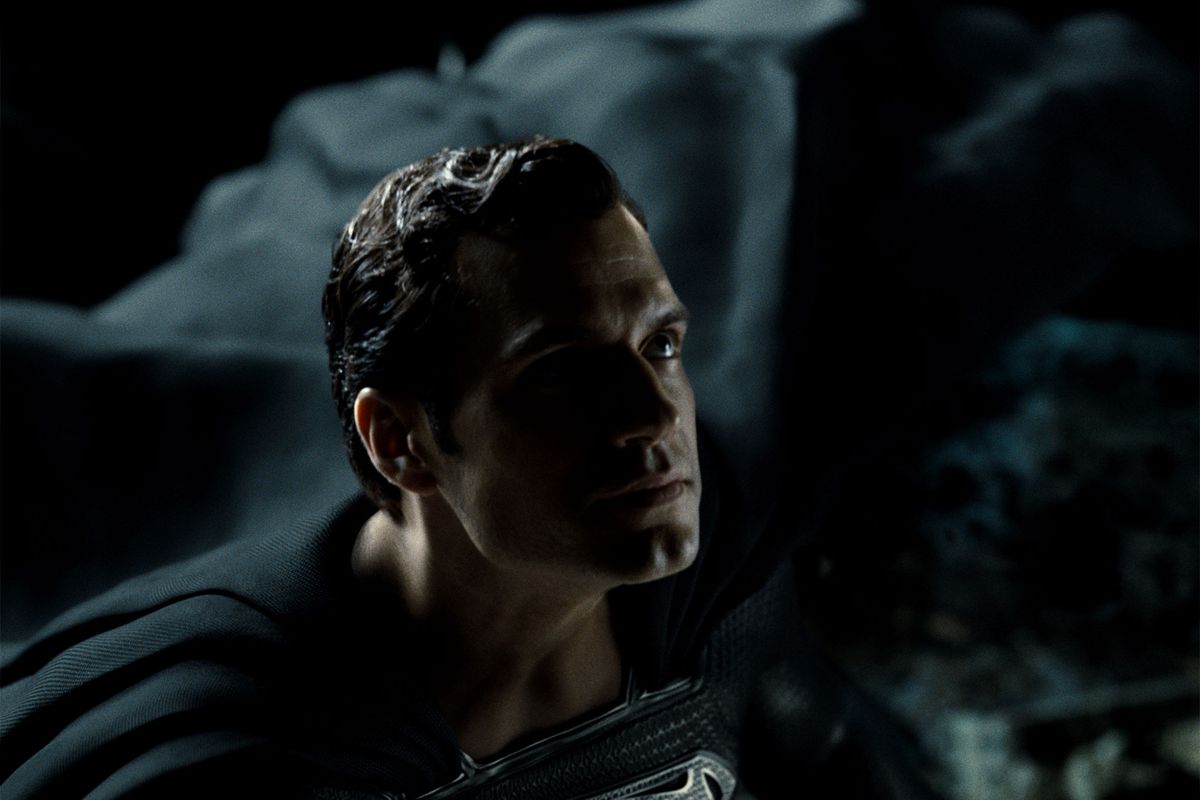
Another of the film’s most successful changes comes with central villain Steppenwolf, a character so badly done a disservice in Whedon’s version the difference is like night and day. Whereas the Whedonwolf seemed to unsuccessfully ape Marvel’s Thanos, Snyder’s take on the character not only allows for a dynamic character arc with motivation (unlike the original, “I’m just here to kill everything blah blah blah” crapfest) but also a near total redesign that absolutely turns Steppenwolf into a total badass. Snyder adds in Steppenwolf’s nephew Darkseid, arguably the biggest, baddest, cosmic-level threat in the entire DC Comic pantheon, as well as Darkseid’s minions Desaad (played by Peter Guinness) and shadowy Granny Goodness, who reside on the distant war world of Apokolips and who search for the famed Anti-life Equation (go Google that for a rabbit hole of what the….), augmenting an already powerhouse bad guy with a backdrop of even more carnage and destruction to come. Steppenwolf’s design is stockier, more muscular, less rubbery than the Whedon design, and the character spend a large portion of the film dressed in an uber-cool spiky quasi-sentient suit of armour that doesn’t translate well in still images. Basically, this Steppenwolf is fucking cool, and the film earns the payoff when he has his showdown with the league.
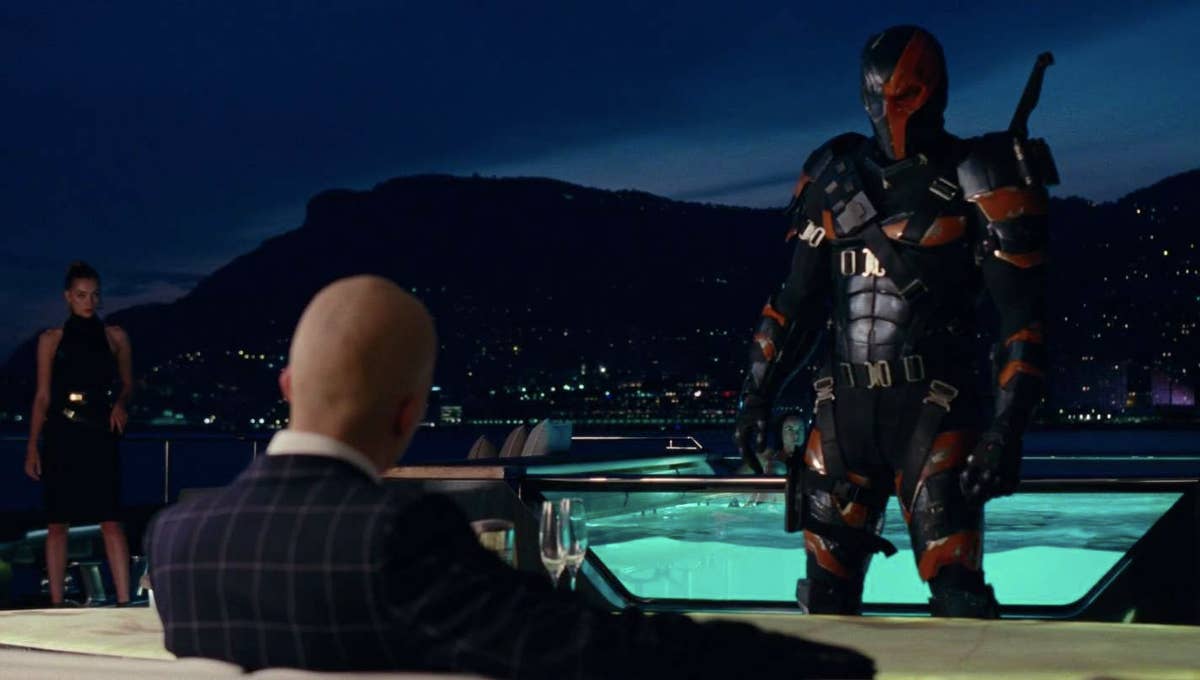
Surrounding the major players, the likes of the aforementioned Joe Morton, the still-underused Amy Adams (who spends the film looking like total shit and eternally sad – Christ, maybe Metropolis is the depression capital of the world?), Willem Dafoe (who pops in as Vulko), Jeremy Irons (as Alfred, Batman’s long-suffering butler), JK Simmons as Commissioner Gordon, who is still hugely underutilised here, and Diane Lane (as Ma Kent) get a chance to further flesh out the character beats and subtleties within Snyder’s grand vision. Some of the stories work – the Lois-Ma Kent subplot is sweet – and some of them doesn’t quite – the considerable sidebar narrative with Momoa’s Aquaman and his Atlantean brethren, including Amber Heard’s Mera, amounts to nought to do with this film, merely setting up the stand-alone film. Nice little additions of entire characters tantalise with what might have been – or what might still be to come. Zheng Kai makes his debut in the DC Universe as Ryan Choi, a scientist working alongside Morton’s Dr Stone at Star Labs and who is better known to comic fans as the current iteration of the Atom. Harry Lennix’s Calvin Swanwick, who appeared in both Man of Steel and Batman V Superman, reveals himself to be another of the DC Universe’s legendary character, the Martian Manhunter himself, J’onn J’onzz, in one of the film’s jaw-dropping reveals.
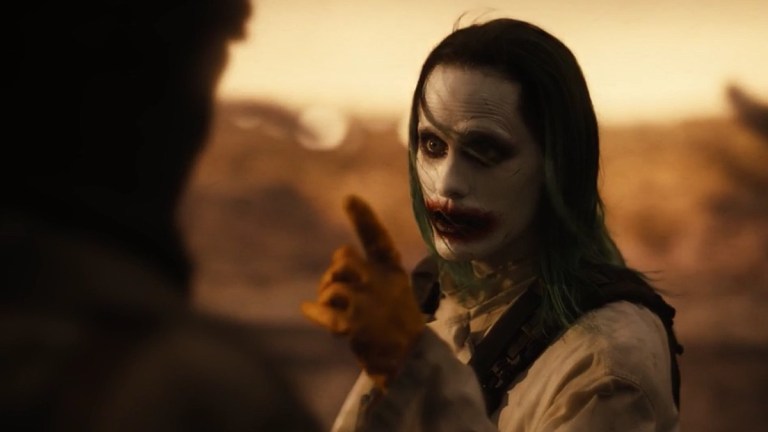
One of the criticisms people have with Zack Snyder’s Justice League is its length. It’s an endurance test of a film, although for fans the time is likely to fly by, and there’s a nugget of truth to the claim that there was never any real need for the movie to clock in at such a heady running time. A lot of the film is spent with unnecessary slow-motion footage, much of which adds nothing to the story other than to look cool, which it does but will hinder value after the twelfth or thirteenth viewing. Make no mistake, the film is a visual (and aural) feast for the senses, with Snyder’s keen eye for detail yet again at the forefront of design and framing, but the question of his editorial decisions to pad out his ultimate kitchen-sink edition simply to satisfy fans as opposed to satisfying the limits of his storytelling ability remains. The film is divided up into 6 “chapters”, plus one epilogue, which serve as mini-break points for the viewer to go grab more popcorn or beer. It’s jaw-dropping to consider that the epilogue, which consists of a slew of entirely new footage, clocks in at a half-hour on its own. That’s longer than the multiple endings for Return Of The King. For most filmmakers not named Peter Jackson or Martin Scorsese this would be inexcusable; Snyder barely gets away with it because he uses the final half hour to not only fatten out his introduction of Joe Manganiello’s Slade Wilson, aka Deathstroke, but also include a lengthy Knightmare sequence in which Jared Leto’s Joker shows up to belittle and antagonise Batman before Superman flies down and…. well, let’s just say the film hints at a major story point for both Lois Lane and Superman, a point hinted at in Batman V Superman’s Flash-forward moment in which Lois is namechecked as the catalyst for the eventual nightmare timeline depicted.
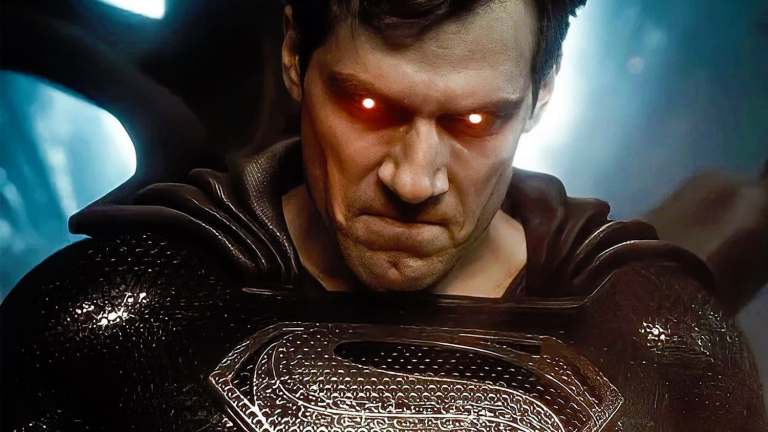
Different viewers will argue eternally about whether the film is long because it’s so unevenly paced (and it is) or whether it’s unevenly paced because it’s so long (again, it is), but the good thing about such length is that it affords us to fully understand Snyder’s vision, for better or worse. Personally I found the additional length quite a positive thing because Snyder could really sink his teeth into developing not just the established characters but even ones we hadn’t fully met before, and in terms of tone the movie is a large step in the direction of more fun, more levity and that was only ever going to be a good thing. It also leaves on a considerable cliff-hanger – I loved it, but the fact that we could quite possibly never see the fruit of this particular tree will leave a somewhat bitter taste in one’s mouth. Love or hate the Snyderverse, I hate an unfinished storyline even more.
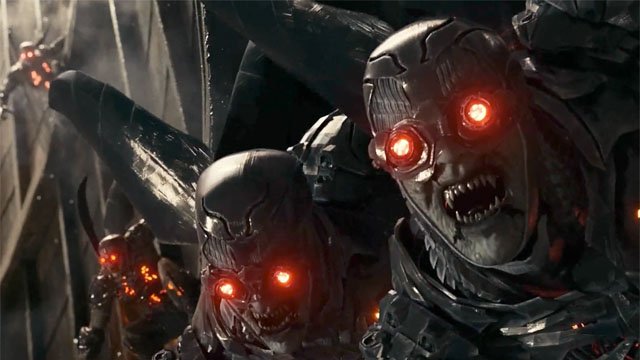
On a technical level, Snyder’s original composer, Tom Holkenberg, returns to score the entire film. Gone is the bombast of the serviceable but wholesale obligatory Danny Elfman score from Whedon’s cut and making its return is Holkenberg’s eclectic, screeching, sonorous and altogether pounding musical accompaniment. Holkenberg reprises Hans Zimmer’s indelible Man of Steel themes whenever Superman appears (or is even mentioned), and his music for the copious lengthy action sequences is a pure audiophile’s delight. Although a large portion of the film’s sub-2300 visual effects shots are resoundingly excellent, there’s a sizeable volume that aren’t, most noticeably in the early Themyscira sequence in which Steppenwolf arrives to steal a Mother Box guarded by Amazons, most of whom ride horses and all of whom only use bow and arrows for defence and attack. Some of the digital human and animal replacement effects in the film are incredibly ropey, so be prepared for that a lot. It’s also worth noting that not even Snyder can make that awful slo-mo running gait of Barry Allen’s look cool at all; it was trash in the Whedon version, and it’s still trash here. Conversely, the updated Parademon design work is superb, turning these creatures from fairly insipid alien knockoffs into legitimately terrifying henchmen for Steppenwolf.
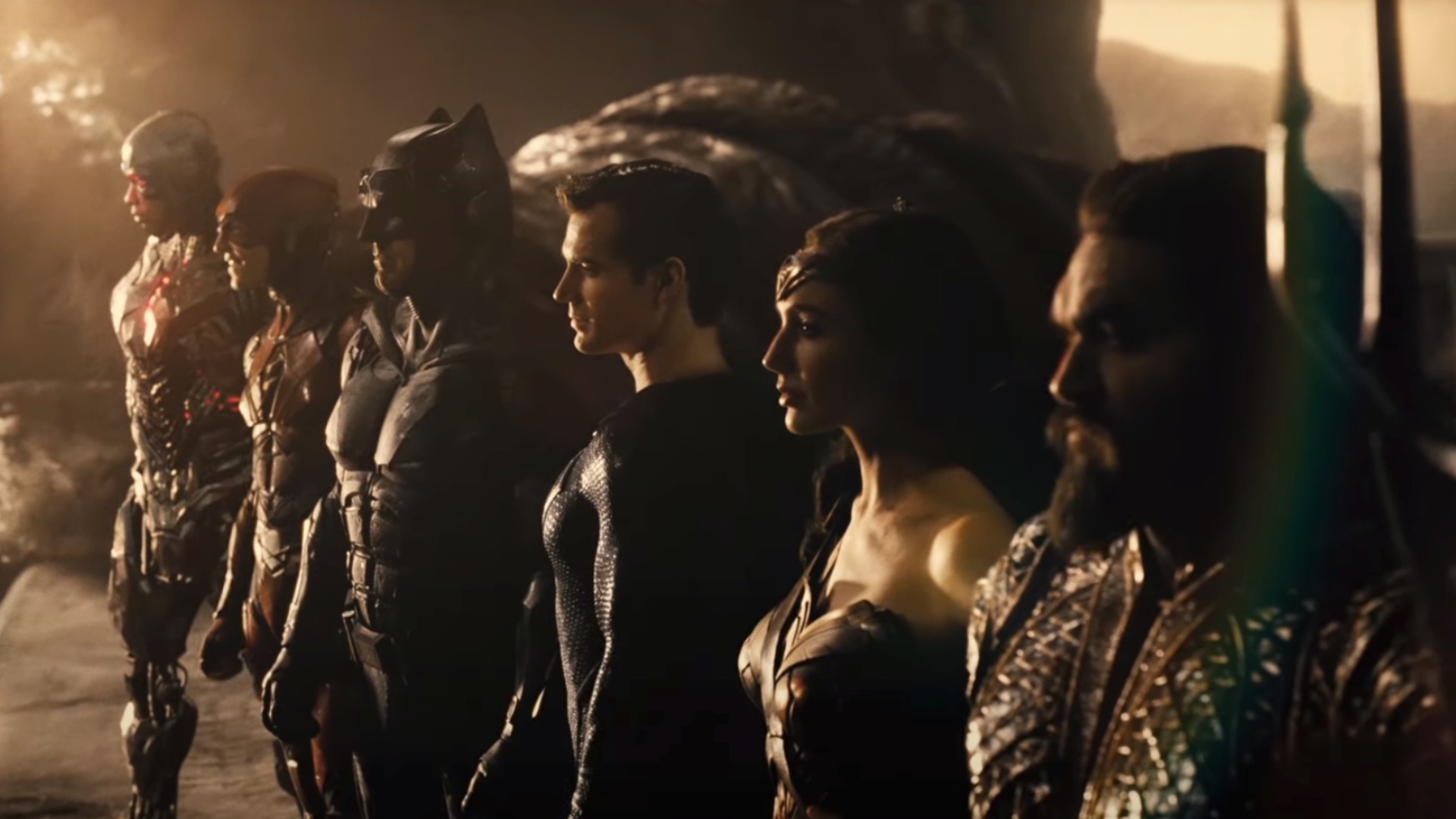
In truth my gripes are largely minor aesthetic ones, hardly anything that will put you off seeing this movie. Folks who aren’t fans of Snyder’s particular visual or tonal approach to the DC cinematic universe won’t suddenly be converted by what the director has accomplished against the odds here; his Justice League most definitely looks and feels like a direct continuation of his previous two films, whether that’s your cup of tea or not. As he’s reiterated, this film is for the fans, and so you should approach it as a fan first. Recognise the flaws, celebrate the successes, and absolutely revel in the fact that a major studio caved to fan pressure to release a cut of a film that required the budget of a minor blockbuster movie to complete and release. Is it a great film? Hard to say after only a few viewings, I suspect time and repeated analytical dissection will reveal a lot about the movie than can be fully grasped so quickly. But it’s a damn good one, an excellent full-stop on Snyder’s DC world, delivering emotionally poignant moments among the explosive and deafening action sequences. If this is where it ends for Snyder with DC, then he’s gone out on a commendably astonishing note.

